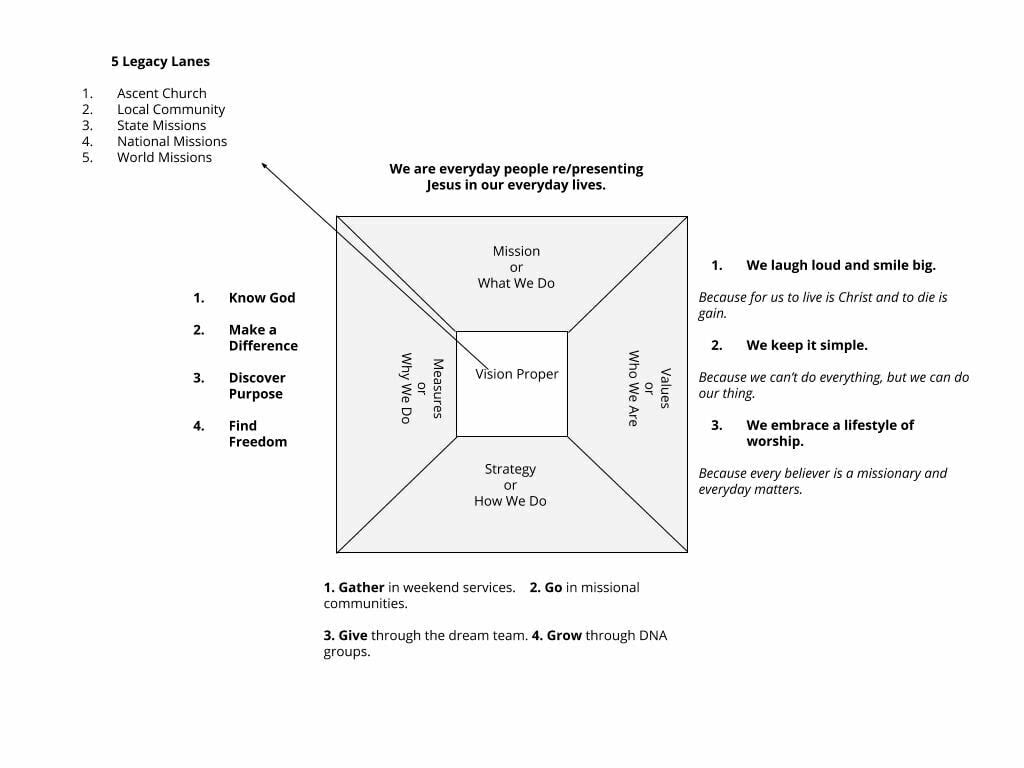|
Today, we are going to look at the first of five legacy lanes and the 32 by 32 vision in greater detail. If you haven’t already please read the rest of our vision series before this post. We have been looking at our vision frame over the last two months on the blog and it all leads to these five weeks. The above picture is our "vision frame" for more on this, check out the first post in this series. If you'd like to view a larger picture of the frame you can do so by clicking here.
We call it a vision frame because it paints a picture of what the future could look like. Of course, we can't see the future and whatever God has in store for us is better than our plans, but that shouldn't stop us from setting our sights on big goals for the glory of God. For Ascent we have identified five areas, we call them legacy lanes, that we believe God has called us to impact. Those areas are Ascent church, our local community, the state of Oklahoma, our nation, and the world. We will look at each of these individually, but in this post we will specifically focus on what we believe God is calling us to do with Ascent Church. The Vision In the last post, I detailed the 32 by 32 vision which is our dream of what Ascent could accomplish by the year 2032. In the post I showed how the vision would play out in each of the five legacy lanes. For the legacy lane regarding Ascent, we said that our goal was to; 1. Have 12 locations throughout rural northwest Oklahoma reaching 3,200 people in weekly attendance. 2. To have 132 missional communities filled with people living out their family servant missionary identities together. I will explain the why and how for both of these goals with the remaining words I have left in this post. Which likely means I will have to be more brief than I want to be, so if you have any questions or thoughts please don’t hesitate to reach out for clarification. Why do we have a goal of 12 locations? Is Ascent trying to be like life.church? Is Ascent going to be “multi-site”? I feel like both of these questions are going to be asked of us whenever we share this vision with others and while I love the ministry of life.church our vision is different. Also, whatever preconception you have of a multi-site church is probably a little different than what we have in mind. We are pursuing a multi-site model because we believe that we will be able to have better ministry environments for less money and be able to invest more in missions. In rural ministry I’ve encountered the following problems:
Here is how I believe a network of churches acting as one church would solve these issues.
How this would work I have a lot left to say, but am going to be brief. First, we will not force anything. If we never have an opportunity to plant a campus, then we won’t. I believe that we will though. The primary way I believe this will work is through churches in target areas coming to us, because they are in danger of closing. We would then revitalize the campus and relaunch as Ascent with people who are already apart of our church and live in that community. Our heart would be to raise up local Elders to serve the campus. 132 Missional Communities The other part of our first legacy lane is the vision to see 132 active missional communities by 2032. This is vital because we believe MC’s are how we actually live out following Christ in our individual everyday lives. We aren’t interested in putting on great Sunday events that people attend. We want to mobilize people to actually living as the church. We want to see people growing in their relationship with God, making a difference, living in their purpose, and truly experiencing freedom. We want to raise up a church of disciples who are making disciples. If we have 132 MC’s, that would be 1,980 to 2,640 people authentically seeking to follow Jesus in the everyday stuff of life. That would be an amazing accomplishment and just the thought of it brings joy to my heart. Can you imagine how northwest Oklahoma would be transformed if that many people were seeking to (re)present and (rep)resent Jesus in everyday life? It would be an awesome place to live and a testimony to the goodness of our Lord. Best case scenario This stuff is cool to think about and consider, but if you're anything like me it's kind of overwhelming. I want to challenge you to think best case scenario with me over the course of this series. I think we drift to worst case scenario by nature. It’s easy for me to wonder if anyone will show up to our first service. It’s much more difficult to imagine things like this. However, remember that God wants us to succeed! We need to have faith that He is going to do amazing things through us for His glory. We may not accomplish any of this by 2032, but we may accomplish ten times as much. We can focus on the worst or the best. I am asking you to dream with me and imagine what God might be doing. I am so blessed to be a part of this journey with you. Thank you for taking time to read this and the rest of our vision series. Let me know your thoughts in the comments below or by emailing me at [email protected]. Pastor Blake
0 Comments
Leave a Reply. |

 RSS Feed
RSS Feed